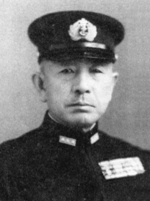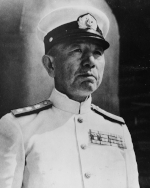Mineichi Koga
| Surname | Koga |
| Given Name | Mineichi |
| Born | 25 Sep 1885 |
| Died | 31 Mar 1944 |
| Country | Japan |
| Category | Military-Sea |
| Gender | Male |
Contributor: C. Peter Chen
ww2dbaseMineichi Koga was born in Arita, Saga Prefecture, Japan. He graduated from the Japanese Naval Academy in 1906. As a midshipman on the cruiser Matsushima, he visited various countries in or bordering the Pacific Ocean, including United States (Hawaii), New Zealand, Australia, Dutch East Indies, China, and Korea. He was promoted to the rank of lieutenant in 1911. Upon completing the Naval War College courses, he was promoted to the rank of lieutenant commander and subsequently held several shore staff positions. He saw no action during WW1. In 1920, he was posted to France for two years. Upon his return, he was named the executive officer of Kitakami. On 1 Dec 1926, he was promoted to the rank of captain. He would return to France as a naval attaché until being recalled in 1930 to serve as the commanding officer of the Yokosuka Naval Station. On 31 Dec 1930, he was named the commanding officer of heavy cruiser Aoba. On 31 Dec 1931, he was named the commanding officer of battleship Ise. On 31 Dec 1932, he was promoted to the rank of rear admiral. He was named the head of the Intelligence Division of the Navy General Staff in 1933. On 31 Dec 1936, he was promoted to the rank of vice admiral.
ww2dbaseAfter the war began, Koga was named the commanding officer of the 2nd Fleet in 1939. On 1 Sep 1941, he was the head of the China Area Fleet. At the onset of the Pacific War between 9 and 31 Dec 1941, he commanded naval operations in support of the invasion of Hong Kong. After Admiral Isoroku Yamamoto's death in Apr 1943, Koga was named as the new commander-in-chief of the Combined Fleet on 21 May 1943, breaking his flag aboard battleship Musashi. He initially planned aggressive operations in order to give the Japanese Navy the offensive initiative again, but as naval aviation forces dwindled, he could only maintain his forces in a defensive posture, hoping to force a decisive engagement as the Americans conducted their next attack.
ww2dbaseIn Mar 1944, during Combined Fleet's withdrawal from Palau Islands to the Philippine Islands, the flying boat which Koga was aboard crashed into the sea during a typhoon. His death was not made public until May 1944 due to war time censorship reasons. He was posthumously promoted to the rank of Fleet Admiral. He now rests at the Tama Reien Cemetery near Tokyo, Japan.
ww2dbaseSource: Wikipedia.
Last Major Revision: Apr 2010
Mineichi Koga Interactive Map
Photographs
 |  |  |  |
Mineichi Koga Timeline
| 25 Sep 1885 | Mineichi Koga was born in Arita, Saga Prefecture, Japan. |
| 1 Dec 1926 | Mineichi Koga was promoted to the rank of captain. |
| 31 Dec 1930 | Mineichi Koga was named the commanding officer of cruiser Aoba. |
| 31 Dec 1931 | Mineichi Koga was named the commanding officer of battleship Ise. |
| 31 Dec 1932 | Mineichi Koga was promoted to the rank of rear admiral. |
| 31 Dec 1936 | Mineichi Koga was promoted to the rank of vice admiral. |
| 1 Sep 1941 | Mineichi Koga was named the head of the China Area Fleet of the Japanese Navy. |
| 21 May 1943 | Mineichi Koga replaced Isoroku Yamamoto as the Commander-in-Chief of the Japanese Navy Combined Fleet. |
| 17 Oct 1943 | Yamato, Musashi, Fuso, Nagato, Kongo, Haruna, Shokaku, Zuikaku, Takao, Atago, Maya, Chokai, Mogami, Suzuya, Tone, Chikuma, Agano, Oyodo, and a destroyer screen sortied from Truk, Caroline Islands to Eniwetok, Marshall Islands with Combined Fleet under Admiral Mineichi Koga's command in response to US Task Force 16 carrier raids on Wake Island. |
| 19 Oct 1943 | Yamato, Musashi, Fuso, Nagato, Kongo, Haruna, Shokaku, Zuikaku, Takao, Atago, Maya, Chokai, Mogami, Suzuya, Tone, Chikuma, Agano, Oyodo, and a destroyer screen arrived at Eniwetok Atoll, Marshall Islands. |
| 20 Oct 1943 | Mineichi Koga ordered the commanders of Shokaku and Zuikaku to prepare for Operation RO, the reinforcement of the Rabaul and New Britain air forces with carrier air groups. |
| 23 Oct 1943 | Yamato, Musashi, Fuso, Nagato, Kongo, Haruna, Shokaku, Zuikaku, Takao, Atago, Maya, Chokai, Mogami, Suzuya, Tone, Chikuma, Agano, Oyodo, and a destroyer screen departed Eniwetok Atoll, Marshall Islands and sortied to a position 250 miles south of Wake Island. |
| 26 Oct 1943 | Yamato, Musashi, Fuso, Nagato, Kongo, Haruna, Shokaku, Zuikaku, Takao, Atago, Maya, Chokai, Mogami, Suzuya, Tone, Chikuma, Agano, Oyodo, and a destroyer screen arrived at Truk, Caroline Islands. |
| 12 Nov 1943 | Admiral Mineichi Koga ordered the remaining Carrier Division 1 aircraft at Rabaul, New Britain to be withdrawn to Truk, Caroline Islands. After the departure of Carrier Division 1, Vice Admiral Jinichi Kusaka noted that 11th Air Fleet had the strength of only 202 aircraft, only 110 of which were combat-ready. |
| 31 Mar 1944 | Mineichi Koga passed away when the flying boat that carried him from Palau Islands to Philippine Islands crashed into the sea in bad weather. |
Please consider supporting us on Patreon. Even $1 per month will go a long way! Thank you. Please help us spread the word: Stay updated with WW2DB: |
Visitor Submitted Comments
All visitor submitted comments are opinions of those making the submissions and do not reflect views of WW2DB.

» Battle of Hong Kong
» Operation Vengeance
Ship(s) Served:
» Aoba
» Ise
» Musashi
- » 1,182 biographies
- » 337 events
- » 45,119 timeline entries
- » 1,248 ships
- » 350 aircraft models
- » 207 vehicle models
- » 376 weapon models
- » 123 historical documents
- » 261 facilities
- » 470 book reviews
- » 28,410 photos
- » 365 maps
George Patton, 31 May 1944
Please consider supporting us on Patreon. Even $1 a month will go a long way. Thank you!
Or, please support us by purchasing some WW2DB merchandise at TeeSpring, Thank you!
28 Aug 2012 07:31:38 PM
His remains and one other were brought to the shores of Barangay Balud, San Fernando roughly 20 miles south of the City of Cebu by the party of naval officers who were accompanying him on that flight together with his chief of staff vice Admiral S Fukudome who was also injured in the crash. They were helped by local fishermen and brought to shore where the injured were treated by local physicians including Fukudome. Word got around and the local resistance called guerrillas took the group prisoners and brought them to the central highlands for safekeeping but not before one member was able to notify the Japanese garrison in Naga a few miles north of what happened to the group. The horror and drama afterwards that led to Fukudome's release was one for the classrooms in military lessons and strategies. Villages were decimated that would put mai Lai to shame. The massacre of civilians continued daily until the Guerrilla central command agreed after a over week to a prisoner of war exchange in the ridgelines over Tabunan. Col. Onishi escorted Fukudome's group back to the city of Cebu to recover and his counterpart, Col James Cushing was demoted to buck private for turning the prisoners over despite a standing order from Canberra to hold the prisoners at all cost. His logic was " at the rate the Japanese were killing civilians there would be nobody left within the year. At wars end, he was reinstated to full Col.and given recognition for making one of the most unique decisions in military history.
pened afterwards were turned overon the southeastern part of Cebu